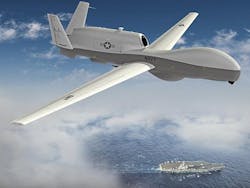Northrop Grumman to provide electronic components for MQ-4C Triton maritime search radar
Officials of the Naval Air Systems Command at Patuxent River Naval Air Station, Md., are asking the Northrop Grumman Mission Systems segment in Linthicum Heights, Md., to provide components for the Triton UAV's Multi-Function Active Sensor (MFAS).
The MFAS is the Triton's maritime search radar that provides the UAV with a 360-degree view of a large geographic area while providing all-weather coverage for detecting, classifying, tracking, and identifying points of interest. MFAS is separate from the MQ-4C Triton air-to-air radar.
The Triton performs maritime surveillance missions as long as 24 hours at altitudes of more than 10 miles to enable coverage out to 2,000 nautical miles. The UAV's suite of sensors can detect and classify different types of ships automatically.
The Triton is a crucial component of the Navy's 21st century strategy for conducting surveillance of surface ship and submarine traffic in the vast Pacific and other oceans around the globe. The MQ-4C Triton UAV works together with the Navy's P-8A Poseidon manned maritime patrol aircraft.
Related: Northrop Grumman to enhance MQ-4C Triton UAV air-to-air radar
Northrop Grumman will prove six antenna group assemblies, six wideband receivers and exciters, 10 radar signal processors (RSP), two antenna drive electronics, and two RSP external power supplies for the MFAS. This order supports low-rate initial production 3 organizational level maintenance for the Triton MFAS.
Along with the air-to-air and MFAS radar systems, the MQ-4C also will carry an electro-optical/infrared (EO/IR) sensor that will provide still imagery and full-motion video of potential threats; an electronic support measures package to identify and geolocate radar threat signals; and an Automatic Identification System (AIS) that will detect and track vessels equipped with AIS responders.
The MQ-4C Triton is designed to provide combat information to military authorities like the expeditionary strike group, carrier strike group, and the joint forces maritime component commander. The Triton air vehicle is based on the U.S. Air Force RQ-4B Global Hawk, while its sensors are based on components and systems already fielded in the U.S. military.
The large unmanned aircraft provides intelligence for large ocean areas to maintain the common operational and tactical picture of the maritime battle space. The Triton feeds intelligence, surveillance, and reconnaissance (ISR) data to the Global Information Grid (GIG), and can work alone or together with other aircraft and surface ships.
Related: Navy orders three MQ-4C Triton long-range unmanned aircraft for maritime surveillance
The MQ-4C Triton's ability to perform persistent ISR within a practical range of 2,000 nautical miles enables the P-8A aircraft to focus on anti-surface ship warfare, anti-submarine warfare (ASW), and multi-intelligence. The Triton can fly as far as 8,200 nautical miles without refueling.
Triton aircraft and support facilities are being based domestically at Point Mugu Naval Air Station near Ventura, Calif., and at Jacksonville Naval Air Station, Fla. Triton UAVs also will be forward-deployed to Kadena Air Base, Japan; Andersen Air Force Base, Guam; Sigonella Naval Air Station, Italy; as well as at installations on the islands of Hawaii and Diego Garcia.
On this order Northrop Grumman will do the work in Linthicum, Baltimore, Annapolis, and Hampstead, Md.; Andover, Mass.; Exeter, N.H.; San Diego; and Stafford Springs, Conn.; as well as other location inside and outside of the Continental U.S., and should be finished by June 2022.
For more information contact Northrop Grumman Mission Systems online at www.northropgrumman.com, or Naval Air Systems Command at www.navair.navy.mil.
Ready to make a purchase? Search the Intelligent Aerospace Buyer's Guide for companies, new products, press releases, and videos
